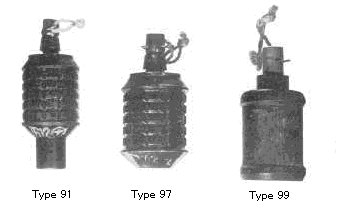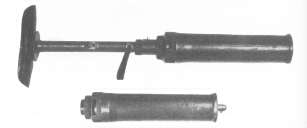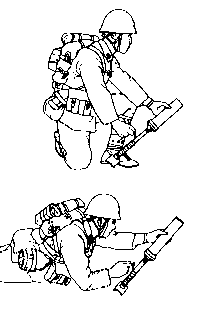
Type 10 can be thrown by hand and also can be launched by Type 10 Grenade Discharger. However, because it was designed for both purposes, its delayed time, about 7 seconds, was too long to throw, and its explosive was too small for the discharger.

Type 91 was base on Type 10, but its explosive was increased by 15g. The bottom part is a case for bursting charge.
Type 97 is basically the same as Type 91, but it was designed for the exclusive purpose of hand grenade. It was lightened by cancelling the bottom case.
Type 99 could be used as both a hand grenade and a shell for the rifle grenade discharger.
At the end of WWII, the ceramic grenades were produced in large numbers, due to the lack of metals. Ones in above photo are typical design, but there are lots of variants on shape, because the design depended on each pottery.
Ceramic grenades were prepared for the battle of the Japan homeland. They were discovered on Iwo Jima in large numbers, but it is unknow that they were actually used in combat.


The armies in Europe developed the grenade discharger attached to the rifle. However, Japanese Army developed the independant grenade discharger. Type 10 was enouth light for infantry to carry, and its range is superior to the rifle grenade discharger.
A right illustration shows the usage of the grenade discharger. Keeping the discharger at 45 degrees of elevation, remove a safty pin of the grenade and insert the grenade into the discharger. By pulling a trigger, the grenade is launched. Though the Japanese grenade discharger is known as "Knee Motar", it never stands on knee. The shooting range can be adjusted by the ring around the bottom of the barrel which changes the size of a hole through which the bursting gas leaks.
Differently from Type 10, the barrel of Type 89 is rifled and the special grenade(Type 89 Grenade, see right photo) was provided for Type 89 discharger. The kill of Type 89 Grenade was three times as much as that of the normal grenade.
Type 89 was heavier than Type 10, but it cauld be disassembled into three components and three men of a grenade discharger unit carried each component. Each Japanese infantry platoon was equipped with three or four grenade dischargers. Type 89 Grenade Discharger was very effective especially in the jungle, because it could be easily transported by infantry and it could fire beyond the obstacles in the jungle. The Americans on the south Pacific islands were very much troubled with the Japanese grenade discharger.
IJA used four kinds of Rifle Grenade Discharger, Type 91, Type 3, Type 2 and Type 100.
Type 91 was for Type 38 Rifle only, and other dischargers could be used by both Type 38 and Type 99 Rifle. The grenade was launched by a blank shot, except Type 100. Type 2 was a special discharger for the anti-tank grenade "Ta-Dan". Above photo is a Type 91 Grenade Discharger.